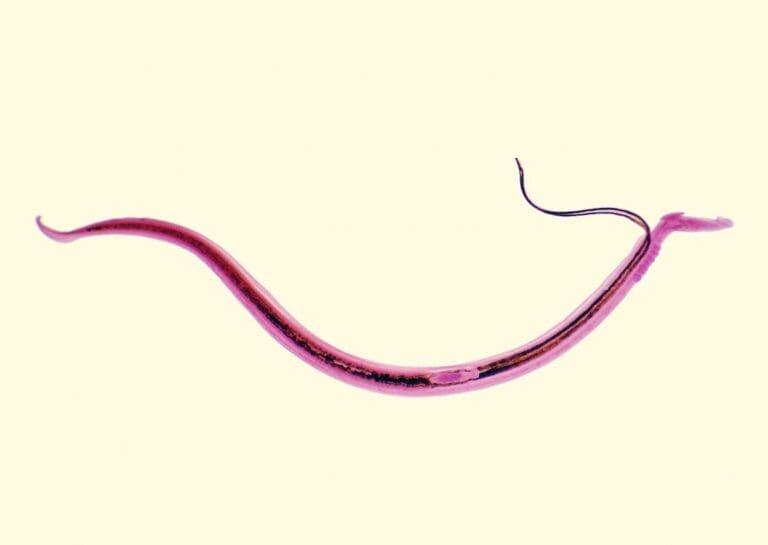What are helminths?
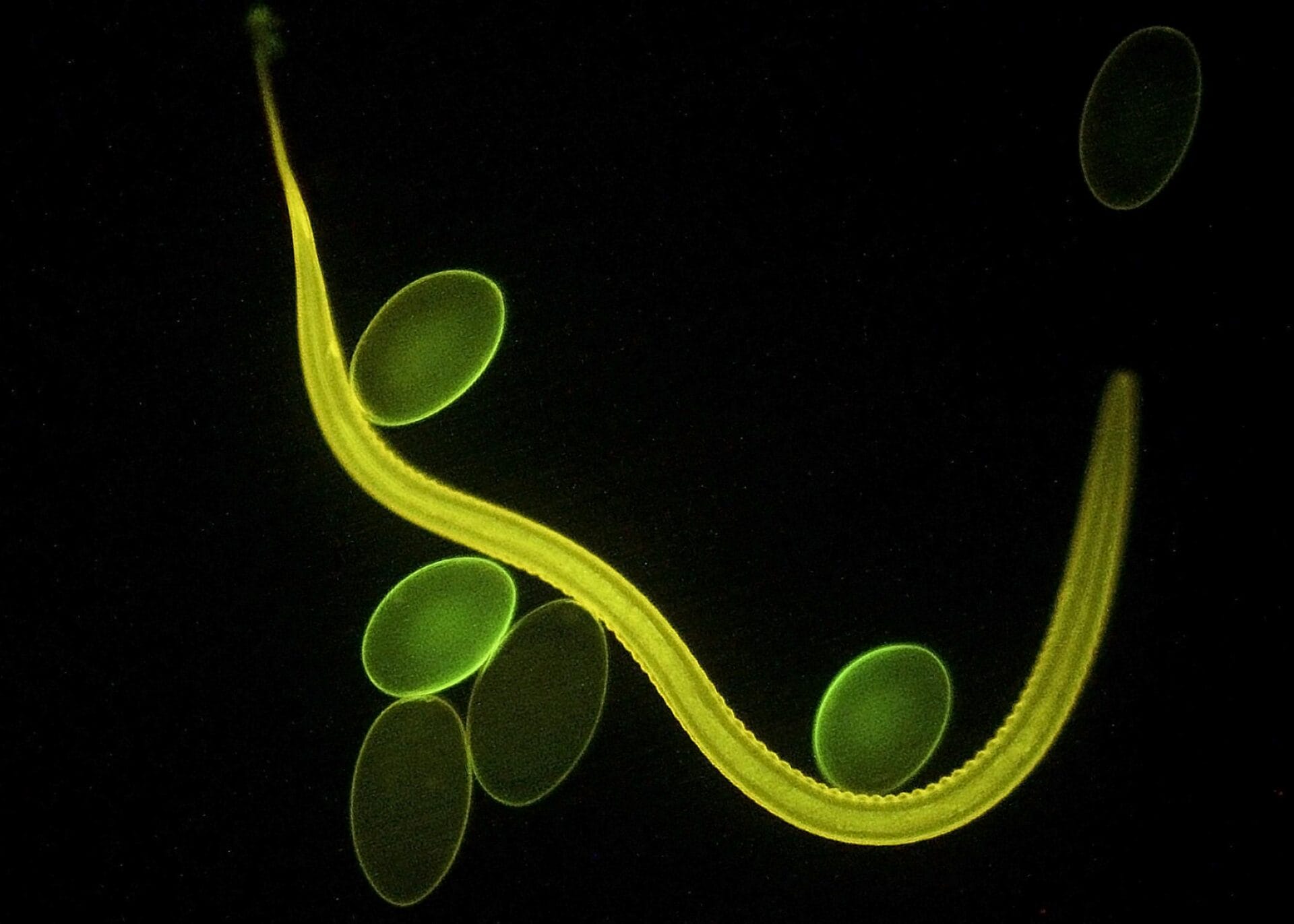
Helminths are worm-like parasites that survive by feeding on a living host to gain nourishment and protection, sometimes resulting in illness of the host.
- ‘Helminth’ is a general term meaning ‘worm’.
- In terms of tropical diseases, helminths are worm-like parasites that feed on their host. Some cause no symptoms, while others cause severe illnesses and long-term damage to organs.
- There are many types of helminths, from the very large to the microscopic.
What are helminths?
- All helminths are invertebrates with long, flat or round bodies.
- There are many kinds of helminth, ranging in length from less than one millimetre to over one metre.
- Helminths infect a range of hosts, including humans. Their effects inside their host also vary, causing a wide spectrum of diseases, from mild to potentially deadly.
- Between 1.5 and 2 billion people around the world are affected by helminth infection – the leading cause of sickness in the developing world.
- Infection can cause physical, nutritional and cognitive impairment in young, developing children.
- In most cases, helminth infections are found in areas with warm, moist climates where sanitation and hygiene are poorer.
- The global burden of helminth disease exceeds that of conditions such as malaria and tuberculosis.
What have helminths taught us about genomics?
- The first animal to have its genome sequenced was Caenorhabditis elegans – a roundworm, or nematode worm, with around 1,000 cells.
- Although C elegans is a very simple organism, sequencing its genome paved the way to a comprehensive view of its development and behaviour.
- Knowing more about the genomes of other helminths could provide useful insights into their biology, potentially leading to new, more effective treatments.
Different types of helminths
Below is an introduction to some of the best understood helminth worms – find out more by clicking on each dropdown box.
The most common types are roundworms and hookworms. They are classified according to their general shape and the part of the host they tend to affect and live in during infection.
Location: Worldwide, but most common in tropical and subtropical regions, including Latin America and sub-Saharan Africa.
Incidence: More than 1 billion people worldwide.
- Roundworms, also called nematodes, are slender worms that can live, feed and reproduce in the human intestine.
- There are thousands of different species of roundworm, several of which infect humans. They range in length from less than a millimetre to a metre.
How do roundworms infect people?
- Infections of roundworm happen more often in warm, tropical climates in poor, rural communities.
- The worms can get into a host’s body when:
- the host eats food or drinks water containing the worms.
- the worm directly penetrates the host’s skin.
- an insect, such as a mosquito, carrying the worm bites the host.
- Roundworm infections usually do not cause noticeable symptoms unless the worms are present in very large numbers. Disease can be caused by the worm living in the gut, blood, lymph or tissues.
- Gut worms are the most prevalent and can be diagnosed by looking under a microscope for worms or eggs in samples of faeces.
How are roundworm infections treated?
- Roundworm infections can be successfully treated with medication, either a course of tablets or a powder that is dissolved in water for young infants. The medication often works by interfering with the worm’s movement or metabolism.
Roundworms
Location: Tropical and subtropical regions.
Incidence: Up to 1 billion people infected worldwide.
- Giant roundworms are very long (often over 30 centimetres in length) and vary in diameter from two to six millimetres. Ascaris lumbricoides is the giant roundworm that infects humans and can grow up to 35 centimetres long.
How do giant roundworms infect people?
- Giant roundworm eggs are deposited into soil in faeces and are transmitted to humans via contaminated food or drink.
- The eggs hatch in the intestines and migrate to the lungs. They are then coughed up out of the lungs into the mouth and consequently swallowed. They travel to the stomach before entering the intestines where they live.
- Around 85% of people who are infected with Ascaris lumbricoides do not show any symptoms, particularly if the number of worms in the body is low.
- If many worms are present in the body, the host may experience vomiting, shortness of breath, swelling in the abdomen or blockages in the intestines.
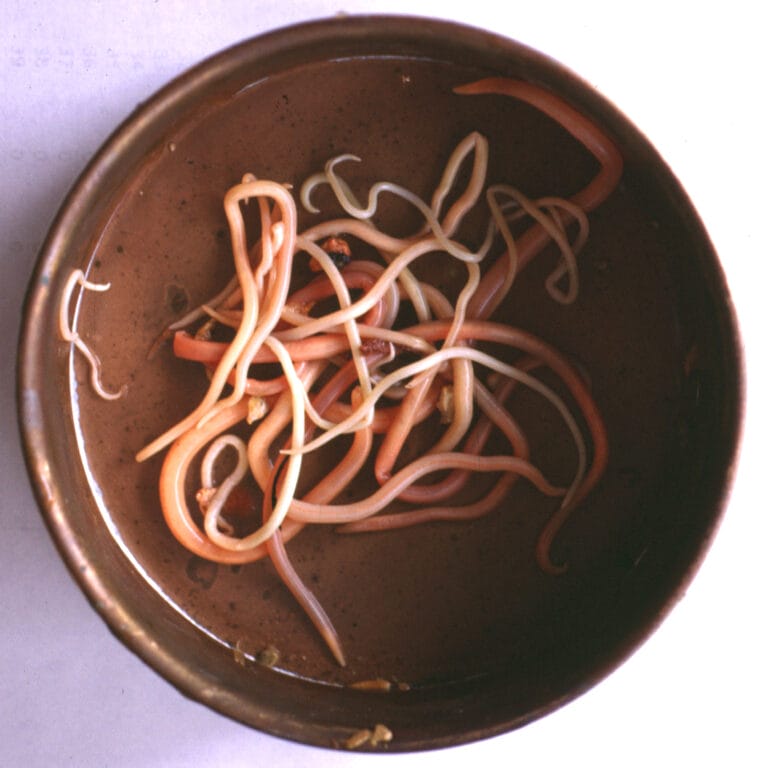
Giant roundworms
Location: Worldwide, but most common in tropical and subtropical countries in Asia and Africa.
Incidence: Around 600-800 million people worldwide.
- Whipworms have a distinctive whip-like shape with a long, thin front end and a thicker tail and are up to eight centimetres in length.
- The whipworm that most commonly infects humans is Trichuris trichiura. It’s sometimes called the human tapeworm.
How do whipworms infect people?
- Trichuris trichiura eggs are deposited into the soil in faeces and transmitted to humans in contaminated food or drink.
- They hatch and develop inside the small intestine and move to the large intestine as adults.
Whipworms could help us to better treat inflammatory bowel diseases.
- Understanding the biology of whipworms shows promise for the development of therapeutic treatments for inflammatory diseases such as ulcerative colitis and Crohn’s disease.
- Diseases like ulcerative colitis and Crohn’s disease are caused by the body’s own immune system attacking areas of the gut.
- These diseases are rarely seen in developing countries where whipworm infection is very common. Scientists believe this could be because the worms help to control the immune response and stop the immune system from attacking the gut lining.
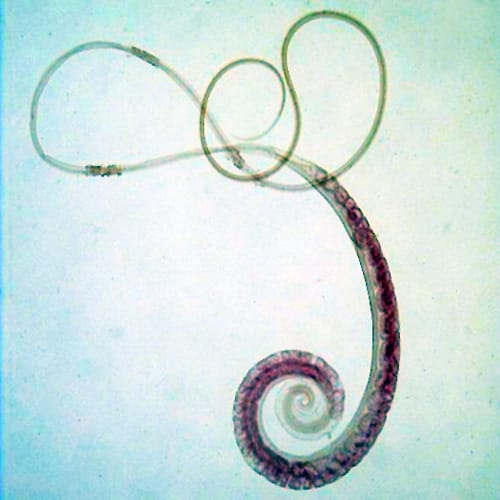
Whipworm
Location: The leading cause of maternal and childhood disease in tropical and subtropical countries.
Incidence: More than half a billion people globally.
- Hookworms are a greyish white or pink colour. Their name comes from the shape of their heads which is slightly bent in relation to the rest of its body, like a hook.
How do hookworms infect people?
- The most common route to infection is through direct skin contact with contaminated soil, often when walking barefoot.
- Different species have different routes to infect the host. For example, Ancyclostoma duodenale have well-developed mouths with two pairs of teeth whereas Necator americanus have a pair of cutting plates that help them latch on.
- After being infected, people can experience an itchy rash around the area where the worm penetrated the skin.
- Hookworms are much smaller than giant roundworms so cause less tissue damage and obstruction.
- In severe infections, hookworms can cause abdominal pain, diarrhoea, fatigue and weight loss. Hookworms are bloodsucking worms and, in some cases, can cause enough blood loss to result in anaemia (iron deficiency).
- The damage caused by hookworms to the intestine can reduce its ability to properly absorb nutrients from food leading to protein deficiency and malnutrition. This is particularly significant in children and pregnant women.
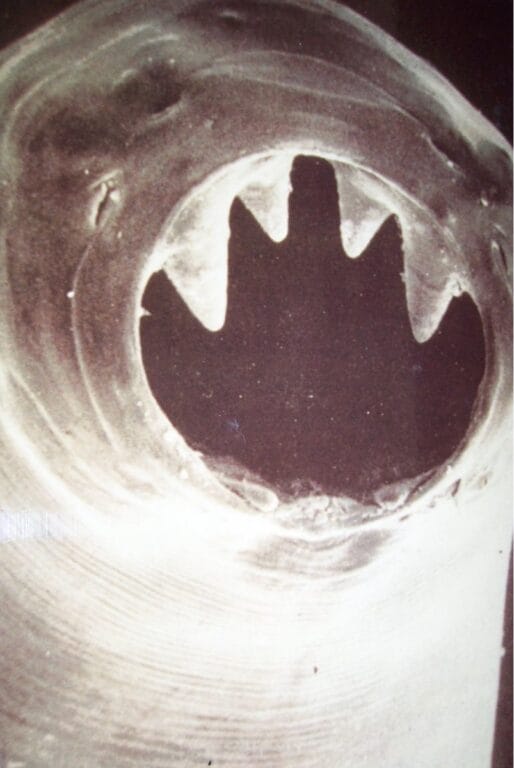
Hookworms
Location: Tropical and subtropical countries in Africa, Asia and South America, as well as the Western Pacific and the Caribbean.
Incidence: At least 120 million people worldwide.
- Filarial worms are thread-like roundworms. Adult filarial worms live for up to eight years and produce millions of larvae that circulate in the blood.
- There are several types, including:
- Wuchereria bancrofti, which is transmitted by mosquito bite and lives in the lymph nodes. It’s a major cause of lymphatic filariasis (sometimes called elephantiasis) – a painful condition that results in swelling and fluid retention.
- Onchocerca volvulus, which is spread by the bite of the Simulium fly. The worm lives in the fat layer of the skin and can cause inflammation and blindness, if it reaches the eye. Since the fly breeds in fast-flowing water, the infection is often called river blindness.
- Scientists are currently working on sequencing the full genomes of filarial worms to learn more about their genetics and how they function in their hosts.
Filarial worms
Location: Worldwide, but the highest rates of infection are in areas of Latin America, Asia and Africa where pigs roam freely and have access to human faeces.
Incidence: Up to 20 million people.
- Tapeworms are flat, ribbon-like worms that live in the intestines of their host. Their scientific name is cestodes.
How do tapeworms infect people?
- Humans can become infected with tapeworm by eating raw contaminated pork, beef or fish, or by consuming food contaminated by faeces from infected animals. Spread is more likely if people don’t wash their hands.
- The tapeworm life cycle involves at least two hosts. The adult worms live in one host (for example, a human), while the larvae live in another host (for example, a pig).
What are the symptoms of tapeworm infection?
- Infection with adult tapeworms rarely causes serious symptoms – so people often won’t know they’re infected until they see segments from the worm in their faeces. These segments look a bit like white grains of rice and contain tapeworm eggs.
- Infections with tapeworm larvae can be deadly if the larvae create cysts within the tissue of their host.
- Different kinds of tapeworm cause different symptoms in humans. For example, fish tapeworms absorb vitamin B12 leading to vitamin B12 deficiency in the host. Vitamin B12 deficiency can lead to mouth ulcers, depression and the skin developing a pale yellow tinge.
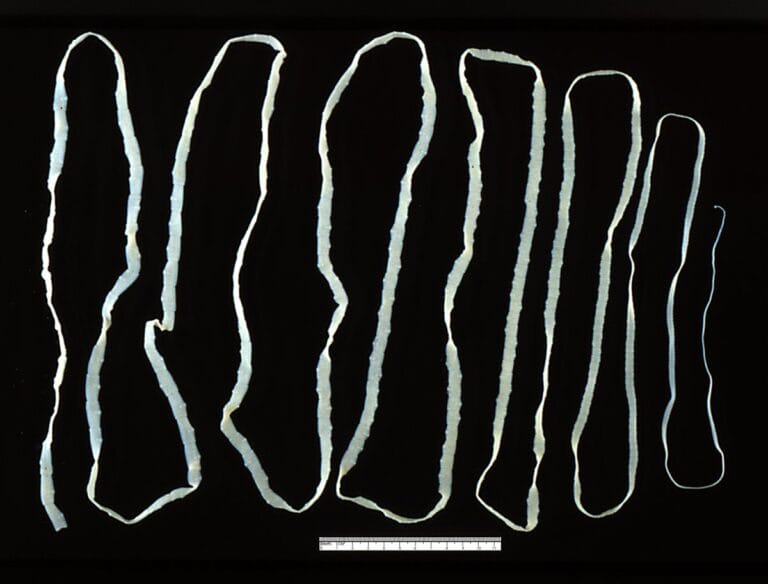
Tapeworms
Location: Most common in Asia, Africa, South America and the Middle East.
Incidence: Blood flukes affect about 240 million people worldwide.
- Trematodes, or flukes, are flattened oval or leaf-shaped worms ranging in length from a few millimetres to seven or eight centimetres.
- Flukes can be classified into two groups – tissue flukes and blood flukes.
Tissue flukes
- Tissue flukes infect the bile ducts, liver or other tissues.
- One example is the Chinese liver fluke, Clonorchis sinensis:
- This fluke lives in the bile ducts of humans and is thought to feed on the epithelial cells there.
- Symptoms include abdominal pain, weight loss and jaundice. These symptoms are caused by swelling or blockage of the bile ducts, the tubes that carry bile from the liver to the intestine.
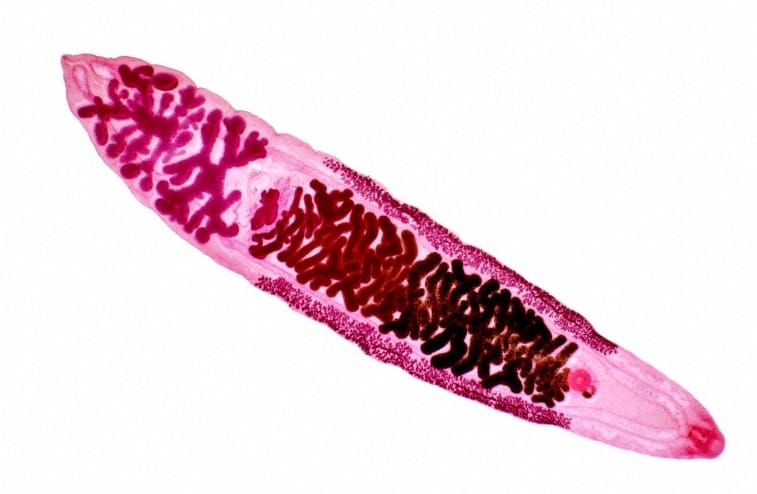
Blood flukes
- All blood flukes belong to the genus Schistosoma. As their name suggests, at some stages of their life cycle blood flukes inhabit the blood of their host.
- People in sub-tropical and tropical areas of the world can become infected with Schistosoma when playing or bathing in fresh water contaminated with schistosome larvae. The larvae burrow directly into the skin.
- Schistosoma parasites cause schistosomiasis (also known as bilharzia). You can read more about this condition here.
